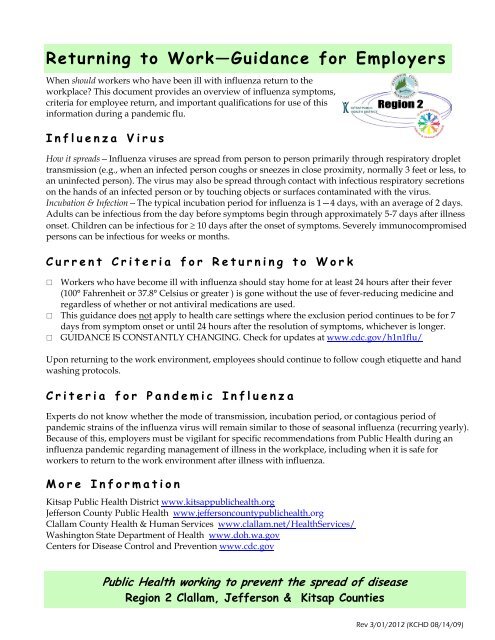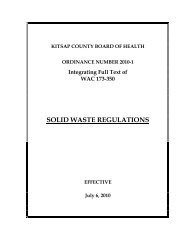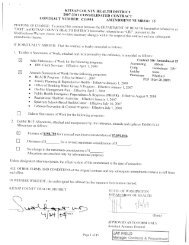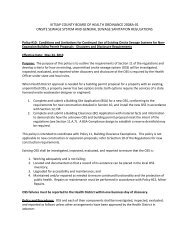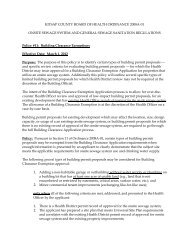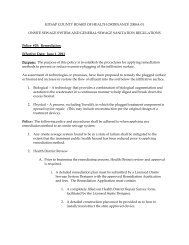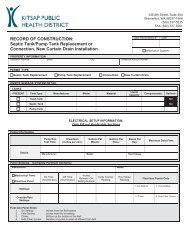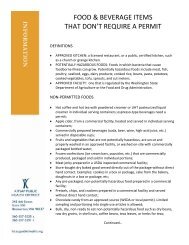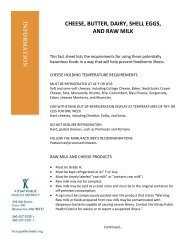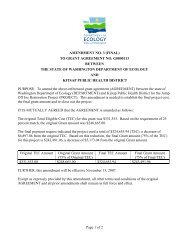Pandemic Flu - Kitsap Public Health District
Pandemic Flu - Kitsap Public Health District
Pandemic Flu - Kitsap Public Health District
Create successful ePaper yourself
Turn your PDF publications into a flip-book with our unique Google optimized e-Paper software.
Returning to Work—Guidance for Employers<br />
When should workers who have been ill with influenza return to the<br />
workplace? This document provides an overview of influenza symptoms,<br />
criteria for employee return, and important qualifications for use of this<br />
information during a pandemic flu.<br />
I n f l u e n z a V i r u s<br />
How it spreads—Influenza viruses are spread from person to person primarily through respiratory droplet<br />
transmission (e.g., when an infected person coughs or sneezes in close proximity, normally 3 feet or less, to<br />
an uninfected person). The virus may also be spread through contact with infectious respiratory secretions<br />
on the hands of an infected person or by touching objects or surfaces contaminated with the virus.<br />
Incubation & Infection—The typical incubation period for influenza is 1—4 days, with an average of 2 days.<br />
Adults can be infectious from the day before symptoms begin through approximately 5-7 days after illness<br />
onset. Children can be infectious for 10 days after the onset of symptoms. Severely immunocompromised<br />
persons can be infectious for weeks or months.<br />
C u r r e n t C r i t e r i a f o r R e t u r n i n g t o W o r k<br />
Workers who have become ill with influenza should stay home for at least 24 hours after their fever<br />
(100° Fahrenheit or 37.8° Celsius or greater ) is gone without the use of fever-reducing medicine and<br />
regardless of whether or not antiviral medications are used.<br />
This guidance does not apply to health care settings where the exclusion period continues to be for 7<br />
days from symptom onset or until 24 hours after the resolution of symptoms, whichever is longer.<br />
GUIDANCE IS CONSTANTLY CHANGING. Check for updates at www.cdc.gov/h1n1flu/<br />
Upon returning to the work environment, employees should continue to follow cough etiquette and hand<br />
washing protocols.<br />
C r i t e r i a f o r P a n d e m i c I n f l u e n z a<br />
Experts do not know whether the mode of transmission, incubation period, or contagious period of<br />
pandemic strains of the influenza virus will remain similar to those of seasonal influenza (recurring yearly).<br />
Because of this, employers must be vigilant for specific recommendations from <strong>Public</strong> <strong>Health</strong> during an<br />
influenza pandemic regarding management of illness in the workplace, including when it is safe for<br />
workers to return to the work environment after illness with influenza.<br />
M o r e I n f o r m a t i o n<br />
<strong>Kitsap</strong> <strong>Public</strong> <strong>Health</strong> <strong>District</strong> www.kitsappublichealth.org<br />
Jefferson County <strong>Public</strong> <strong>Health</strong> www.jeffersoncountypublichealth.org<br />
Clallam County <strong>Health</strong> & Human Services www.clallam.net/<strong>Health</strong>Services/<br />
Washington State Department of <strong>Health</strong> www.doh.wa.gov<br />
Centers for Disease Control and Prevention www.cdc.gov<br />
<strong>Public</strong> <strong>Health</strong> working to prevent the spread of disease<br />
Region 2 Clallam, Jefferson & <strong>Kitsap</strong> Counties<br />
Rev 3/01/2012 (KCHD 08/14/09)


